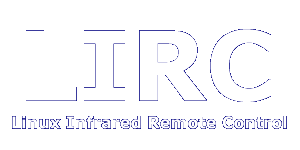

| |
Driver Model| +---------------------------------------------------------------+ S | | 'gpm -t msc -m /var/run/lirc/lircm' or a well configured X | O | | (see section 'Configuring lircmd') for details | F | +--------------+------------------------------------------------+ T | | W | /var/run/lirc/lircm (named pipe (FIFO) ==> one connection) A | | R | +-----------+-----------+ +-------------------------------+ E | | mouse daemon (lircmd) | | tools (irexec, irxevent, ...) | | | configured with | | configured with ~/.lircrc | | | lircmd.conf | | | | +-----------+-----------+ +-----------+-------------------+ | | | | +-------------+-------------+ | | | /var/run/lirc/lircd (socket ==> multiple connections) | | S | +----------------+--------------------------+ O | | decoder daemon (lircd), irrecord or mode2 | TCP/IP F | | lircd is configured through lircd.conf +--- port T | User space | | 8765 W | +------------------+------------------------+ A | | | R | | | E | | | | | /dev/uinput (Linux input layer) | | | | +---------------------------------+---------------------------------- | Kernel space | (character device | | driver ==> | +------------+----------+ one connection) | | | | /dev/lirc /dev/ttySx | | | | +------------+-------------+ +-----+---------------+ | | LIRC device driver | | Linux serial driver | | | (with ioctl-interface) | | | | +------------+-------------+ +----------+----------+ | | | --+--------------------+----------------------------+------------------ | | | | +----------+------------+ | | | | | | +-------+----------------+ +----+-----+ +-------+-----------------+ H | | serial / parallel port | | TV cards | | Irman/RemoteMaster/etc. | W | +------------------------+ +----------+ +-------------------------+ | Formats
Writing TV card drivers using lirc_devThe lirc_dev module is a helper and abstraction layer for other modules. It registers /dev/lirc device in a system (including support for devfs) and waits for plugin registration. After that it serves device requests (open, read, poll, ioctl, close) and if needed calls callback functions from plugin(s) to communicate with the physical device. Plugins can be registered and unregistered many times. The current implementation allows two concurrent plugins, but can be easily changed by increasing the MAX_IRCTL_DEVICES definition. It also allows receiving of scan codes, which have more than 8 bits. Current limit for a scan code is 16*8 bits and also can be changed by increasing the BUFLEN definition.
For an API description see lirc_dev.h. The lirc_gpio
module can be treated as examples of using this API.
Warning: Due to the used kernel API it requires kernel
2.2.4 or higher. Writing Applications for LIRCAs LIRC is able to both receive and send IR commands there are two possible types of applications. Programs that send IR commands like xrc and irsend or programs that receive commands like irexec, irxevent and irpty. Both types of applications will have to connect to the lircd daemon using the socket interface usually located in /var/run/lirc/lircd. Communication on the socket uses human readable format. The end of a line is indicated by a newline character. Whenever lircd receives a IR signal it will broadcast the following string to each client: <code> <repeat count> <button name> <remote control name>
code is a 64-bit encoding (in hexadecimal
representation) of the IR signal. It's usage in applications is
deprecated and should be ignored. The repeat count
shows how long the user has been holding down a button. The
counter will start at 0 and increment each time a new IR signal
has been received. The button name and remote
control name are defined in the lircd config file. Their
purpose should be quite self-explanatory. They must not contain
any whitespace. Applications that want to send out IR commands can use the following commands: SEND_ONCE <remote control name> <button name> [<repeat count>] SEND_START <remote control name> <button name> SEND_STOP <remote control name> <button name> The SEND_ONCE directive tells lircd to send the IR signal associated with the given remote control and button name, and then repeat it repeat count times. repeat count is a decimal number between 0 and repeat_max. The latter can be given as a command line argument to lircd, and defaults to 600. If repeat count is not specified or is less than the minimum number of repeats for the selected remote control, the minimum value will be used. SEND_START tells lircd to start repeating the given button until it receives a SEND_STOP command. However, the number of repeats is limited to repeat_max. lircd won't accept any new send commands while it is repeating. lircd also understands the following commands: VERSION LIST [<remote control name>]
The response to the VERSION command will be a packet containing
lircd's version. There still remains to explain the format of lircd's reply packets. Here is a formal description of the packets: BEGIN <command> [SUCCESS|ERROR] [DATA n n lines of data] END
The protocol guarantees that broadcasted messages won't
interfere with reply packets. But broadcasts may appear at any
point between packets. command is the command lircd is
currently processing. Its an exact copy of the command the
client application has sent. The only exception are SIGHUP
packages where command is substituted with SIGHUP. Note
that SIGHUP packages may appear just after you have sent a
command to lircd, so you have to make sure you don't confuse
them with replies. SIGHUP packages come without any further data
while each reply to a command contains either SUCCESS or ERROR
indicating the result of processing the command. In case of an
error the following data is a message explaining the
problem. This message can be used to create an error message for
the user. The lirc_client libraryIf you only want to make your application receive IR commands and if you don't want to mess with all the protocol stuff you can use the lirc_client library that comes with LIRC since version 0.6.0. With the help of this library your program can look as simple as this:
/* $Id: technical.html,v 1.34 2010/01/30 15:01:29 lirc Exp $ */
/****************************************************************************
** irexec.c ****************************************************************
****************************************************************************
*
* irexec - execute programs according to the pressed remote control buttons
*
* Copyright (C) 1998 Trent Piepho <xyzzy@u.washington.edu>
* Copyright (C) 1998 Christoph Bartelmus <lirc@bartelmus.de>
*
*/
#ifdef HAVE_CONFIG_H
# include <config.h>
#endif
#include <errno.h>
#include <unistd.h>
#include <stdarg.h>
#include <stdio.h>
#include <stdlib.h>
#include <string.h>
#include "lirc_client.h"
char *progname;
int main(int argc, char *argv[])
{
struct lirc_config *config;
progname=argv[0];
if(argc>2)
{
fprintf(stderr,"Usage: %s <config file>\n",progname);
exit(EXIT_FAILURE);
}
if(lirc_init("irexec",1)==-1) exit(EXIT_FAILURE);
if(lirc_readconfig(argc==2 ? argv[1]:NULL,&config,NULL)==0)
{
char *code;
char *c;
int ret;
while(lirc_nextcode(&code)==0)
{
if(code==NULL) continue;
while((ret=lirc_code2char(config,code,&c))==0 &&
c!=NULL)
{
#ifdef DEBUG
printf("Execing command \"%s\"\n",c);
#endif
system(c);
}
free(code);
if(ret==-1) break;
}
lirc_freeconfig(config);
}
lirc_deinit();
exit(EXIT_SUCCESS);
}
Before anything else you have to include the header file for the lirc_client library. This is done with #include <lirc/lirc_client.h> Note that our example differs in this point because it was taken directly from the lirc-0.6.0 source that comes with its own lirc_client.h but we have to use the one that is already installed on the system. The next step is to initialize the library code with lirc_init(). This function connects to lircd and does some internal init stuff. int lirc_init(char *prog,int verbose); The first argument to this function is the string users will have to provide as prog token in their .lircrc config files. If the second argument is non-zero error messages will be printed to stderr. Otherwise no error messages will ever be displayed. This function returns the file descriptor of the socket that is connected to lircd or -1 if an error occurred. The example continues by reading a config file. This is done by the lirc_readconfig() function: int lirc_readconfig(char *file,struct lirc_config **config, int (check)(char *s));
If you want to load the default config file you should pass NULL
as first argument. If you want to load some other config file
the file argument should contain the complete path to
the file. Your program should give the user the possibility to
use an other than the default config file. You should also be
able to load multiple config files by calling this function
several times. The lirc_nextcode() function blocks until there is something available on the lircd socket. This way it can be used in the main loop of your program like in our example. int lirc_nextcode(char **code);
If an error occurs (usually this means that the socket has been
closed by the daemon) this function returns -1. Otherwise it
returns 0 and code points to the next string available
in the data stream. This string has to be freed by your
application using the free(3) function. If no complete
string is available code will be NULL. To get the config string that the user has provided in the config file in response to a button press you use the following function: int lirc_code2char(struct lirc_config *config,char *code,char **string); config is a pointer to the config file data structure that you can get with lirc_readconfig() and code is the code transmitted to your application on the lircd socket. If an action should be taken string will point to the config string the user has provided in the config file. The user might want to take several actions on a button press so you have to execute this function until string is NULL, which means that no more actions shall be taken, or an error occurs. The function returns -1 if an error occurred, 0 otherwise. In our example there are only two clean-up functions to be explained. void lirc_freeconfig(struct lirc_config *config); This functions frees the data structures associated with config. int lirc_deinit(); lirc_deinit() closes the connection to lircd and does some internal clean-up stuff. I encourage you to use autoconf and automake for your projects. To check for the lirc_client library all you have to insert into your configure.ac (or configure.in) file is the following: dnl Check for LIRC client support dnl This really is not worth making a separate file for it. have_lirc=yes AC_REQUIRE_CPP AC_CHECK_LIB(lirc_client,lirc_init, AC_CHECK_HEADER(lirc/lirc_client.h,true,have_lirc=no),have_lirc=no) if test "$have_lirc" = "yes"; then dnl AC_DEFINE(HAVE_LIRC); true; else AC_MSG_ERROR([*** LIRC client support not available ***]); fi There is also a more complex m4 macro in the contrib directory of the current LIRC distribution if you plan to add LIRC support to your application without using the lirc_client library. While developing LIRC applications you might find a emulator for lircd useful. With this emulator you don't need a remote control to generate LIRC events. That way you can develop LIRC applications even if you don't have a LIRC compatible device yourself. lircrcd protocollircrcd syntactically uses the same protocol as lircd described in the last section. It supports the following commands:
Note for packagersIf you want to make a binary package for lirc (.deb, .rpm, ...), there are a couple of goodies you can take advantage of:
Finally, you should consider installing the doc/lirc.hwdb file. This one is a parseable list of LIRC supported devices, which is useful for LIRC configuration applications. You should also have a look at the below HAL integration description. For more information, refer to the next section. Hardware Abstraction Layer (HAL) integrationIf your system support the FreeDesktop Hardware Abstraction Layer (HAL), you will want to install the file contrib/hal/20-ircontrol-lirc.fdi in ${datarootdir}/hal/fdi/information/20thirdparty
This file can be generated at will using contrib/hal/gen-hal-fdi.pl. This is a work in progress. We will also provide more information in the future, such as the driver/manufacturer/device name(s), and possibly event reporting. Note for configuration application developers
If you want to make a configuration application, lirc provides
a parseable list of LIRC supported devices. Known bugs
The LIRC Manual, last update: 24-May-2009 |
|